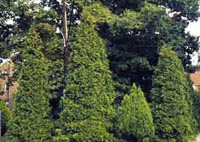Resource Library
Plant of the Week: Arborvitae
The University of Arkansas System Division of Agriculture does not promote, support or recommend plants featured in "Plant of the Week." Please consult your local Extension office for plants suitable for your region.
Plant of the Week
Arborvitae
Latin: Thuja orientalis

Fashion is a fickle friend. One day you know what’s happening, and the next you discover it’s all changed.
Gardening is no more immune to the ebb and flow of trends than any other segment of our society, but because plants are more difficult to discard than a pair of bell bottom pants, we see relics of past trends in contemporary landscapes. And just as with any good trend, they usually get recycled every 30 to 50 years.
During the first half of the 20th century, needled evergreens such as arborvitaes and junipers were a hot item in landscapes. A major reason for this popularity was because the nursery industry was located in the upper Midwest and New England states, and these were the kinds of evergreens that would survive their cold winters. One of the plants that achieved considerable popularity during this period was the Oriental arborvitae, Thuja orientalis.
The Oriental arborvitae is an egg-shaped plant with innumerable branches radiating from the base to the tip. The needles are held erect in flat, hand-shaped arrays that give the plant a neat, compact appearance. That is until an ice storm hits, and then it parts down.
Is it a tree or a shrub? Given enough time the Oriental arborvitae will reach tree-like stature. But most gardeners plant it in impossibly cramped quarters where annual shearings keep it somewhat under control and with more bush-like dimensions.
The American love affair with needled evergreens sputtered and failed, primarily because of the voracious appetite of an insect called the bagworm. This switch began after WWII and was pretty much complete by the end of the Viet Nam war, with the new darlings of the landscape being hollies and azaleas. Of all the needle leaf evergreens, the arborvitae must taste the best for it seemed to always be the first attacked, so it was the first to be removed from the landscape.
The bagworm is a native insect that most of us notice in August when we awake to bare branches festooned with ugly, 2-inch long bagworm cases. At this late date, the cases are cigar shaped with a bulge in the middle and attached to the branch by a silken thread, a sign the female insect inside is pupating and will soon be eagerly awaiting a visit from an amorous male.
The female moth is flightless and never leaves the protective confines of the case. The outer surface is camouflaged with bits and pieces of the plant on which the insect has been feeding.
Most of us miss the insect when it begins its life cycle. The female, after mating with the male, lays her eggs and then promptly dies. The eggs overwinter in the bagworm case with hatching occurring in mid to late May. The young larvae spins a silken thread to serve a parachute and jumps off the bush, trusting that the winds will carry it to some hospitable and tasty abode. Once it alights, it begins feeding and builds the case over its abdomen to protect it from birds. At this stage, the insects are free to move about the shrub to consume anything green. By mid June the insects are about a quarter-inch long; in another month they will be reaching maturity.
Control is not especially difficult if it is started early in the season. The first step is to bribe a grandchild into collecting every bagworm case on the bush. This reduces the insect pressure and in rare cases (such as an isolated planting) may be sufficient for control.
But in most situations, spraying with the insecticide Sevin or the biological control agent Dipel will be needed to ensure complete control. Bagworms become increasingly difficult to control as they get larger, so many gardeners simply spray as a matter of course in late May or early June and get the insects when they first start feeding, well before any evidence of damage can be seen.
By: Gerald Klingaman, retired
Extension Horticulturist - Ornamentals
Extension News - June 20, 2003
The University of Arkansas System Division of Agriculture does not maintain lists of retail outlets where these plants can be purchased. Please check your local nursery or other retail outlets to ask about the availability of these plants for your growing area.